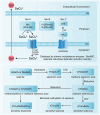Unveiling the vital role of soil microorganisms in selenium cycling: a review
- PMID: 39323878
- PMCID: PMC11422209
- DOI: 10.3389/fmicb.2024.1448539
Unveiling the vital role of soil microorganisms in selenium cycling: a review
Abstract
Selenium (Se) is a vital trace element integral to numerous biological processes in both plants and animals, with significant impacts on soil health and ecosystem stability. This review explores how soil microorganisms facilitate Se transformations through reduction, oxidation, methylation, and demethylation processes, thereby influencing the bioavailability and ecological functions of Se. The microbial reduction of Se compounds, particularly the conversion of selenate and selenite to elemental Se nanoparticles (SeNPs), enhances Se assimilation by plants and impacts soil productivity. Key microbial taxa, including bacteria such as Pseudomonas and Bacillus, exhibit diverse mechanisms for Se reduction and play a substantial role in the global Se cycle. Understanding these microbial processes is essential for advancing soil management practices and improving ecosystem health. This review underscores the intricate interactions between Se and soil microorganisms, emphasizing their significance in maintaining ecological balance and promoting sustainable agricultural practices.
Keywords: biogeochemical cycling; microorganisms; selenium; selenium reduction; soil.
Copyright © 2024 Jiang, Wang, Zhao and Peng.
Conflict of interest statement
The authors declare that the research was conducted in the absence of any commercial or financial relationships that could be construed as a potential conflict of interest.
Figures



Similar articles
-
Formation of Se (0) nanoparticles by Duganella sp. and Agrobacterium sp. isolated from Se-laden soil of North-East Punjab, India.Microb Cell Fact. 2012 Jul 9;11:64. doi: 10.1186/1475-2859-11-64. Microb Cell Fact. 2012. PMID: 22607265 Free PMC article.
-
Reduction of selenite to Se(0) nanoparticles by filamentous bacterium Streptomyces sp. ES2-5 isolated from a selenium mining soil.Microb Cell Fact. 2016 Sep 15;15(1):157. doi: 10.1186/s12934-016-0554-z. Microb Cell Fact. 2016. PMID: 27630128 Free PMC article.
-
Selenium Nanoparticles as an Innovative Selenium Fertilizer Exert Less Disturbance to Soil Microorganisms.Front Microbiol. 2021 Sep 13;12:746046. doi: 10.3389/fmicb.2021.746046. eCollection 2021. Front Microbiol. 2021. PMID: 34589080 Free PMC article.
-
Microbial reduction and resistance to selenium: Mechanisms, applications and prospects.J Hazard Mater. 2022 Jan 5;421:126684. doi: 10.1016/j.jhazmat.2021.126684. Epub 2021 Jul 20. J Hazard Mater. 2022. PMID: 34339989 Review.
-
Microbial Transformations of Selenium Species of Relevance to Bioremediation.Appl Environ Microbiol. 2016 Jul 29;82(16):4848-59. doi: 10.1128/AEM.00877-16. Print 2016 Aug 15. Appl Environ Microbiol. 2016. PMID: 27260359 Free PMC article. Review.
Cited by
-
Bioremediation Potential of Rhodococcus qingshengii PM1 in Sodium Selenite-Contaminated Soil and Its Impact on Microbial Community Assembly.Microorganisms. 2024 Nov 29;12(12):2458. doi: 10.3390/microorganisms12122458. Microorganisms. 2024. PMID: 39770660 Free PMC article.
-
Microbial diversity and community assembly in heavy metal-contaminated soils: insights from selenium-impacted mining areas.Front Microbiol. 2025 Apr 14;16:1561678. doi: 10.3389/fmicb.2025.1561678. eCollection 2025. Front Microbiol. 2025. PMID: 40297287 Free PMC article.
-
Phylotaxonomic analysis uncovers underestimated species diversity within the genus Rossellomorea with description of selenium-resistant Rossellomorea yichunensis sp. nov.BMC Microbiol. 2025 Jul 3;25(1):408. doi: 10.1186/s12866-025-04138-6. BMC Microbiol. 2025. PMID: 40610858 Free PMC article.
-
Selenium-Enriched Microorganisms: Metabolism, Production, and Applications.Microorganisms. 2025 Aug 7;13(8):1849. doi: 10.3390/microorganisms13081849. Microorganisms. 2025. PMID: 40871353 Free PMC article. Review.
References
-
- Abbood H. Y., Al-Shammari A. A. H. (2021). Effect of spraying with Nano selenium and salicylic acid in reducing salt stress and growth and yield of corn (Zea Mays L.). NVEO Nat. Volatiles Essent. Oils J. NVEO, 8, 1903–1922.
-
- Afkar E. (2012). Localization of the dissimilatory arsenate reductase in Sulfurospirillum barnesii strain SeS-3. Am. J. Agric. Biol. Sci. 7, 97–105.
-
- Al-Hagar O. E., Abol-Fotouh D., Abdelkhalek E. S., Elsoud M. M. A., Sidkey N. (2021). Bacillus niabensis OAB2: outstanding bio-factory of selenium nanoparticles. Mater. Chem. Phys. 273:125147. doi: 10.1016/j.matchemphys.2021.125147 - DOI
-
- Alonso-Fernandes E., Fernández-Llamosas H., Cano I., Serrano-Pelejero C., Castro L., Díaz E., et al. . (2023). Enhancing tellurite and selenite bioconversions by overexpressing a methyltransferase from Aromatoleum sp. CIB. Microb. Biotechnol. 16, 915–930. doi: 10.1111/1751-7915.14162, PMID: - DOI - PMC - PubMed
Publication types
LinkOut - more resources
Full Text Sources

